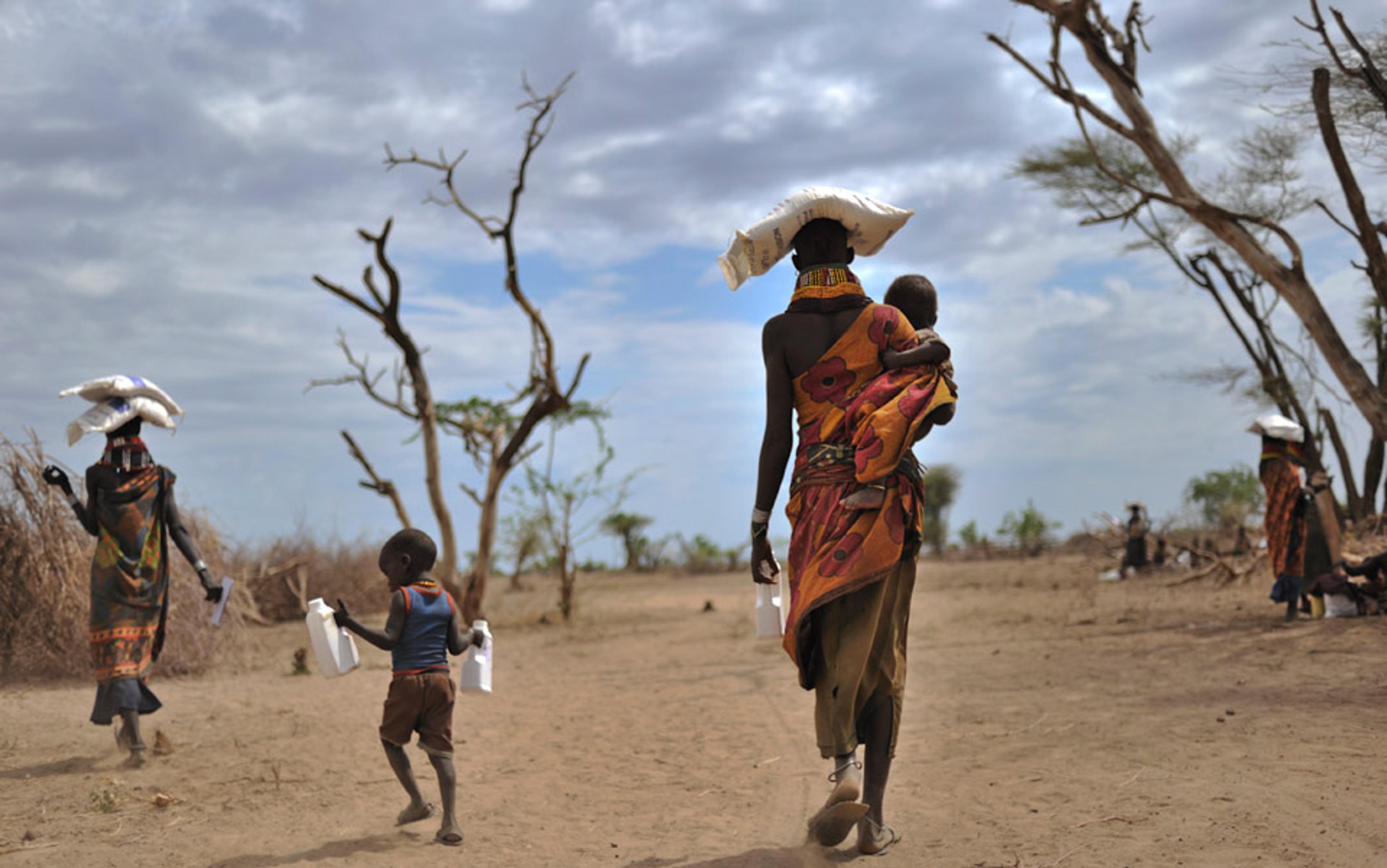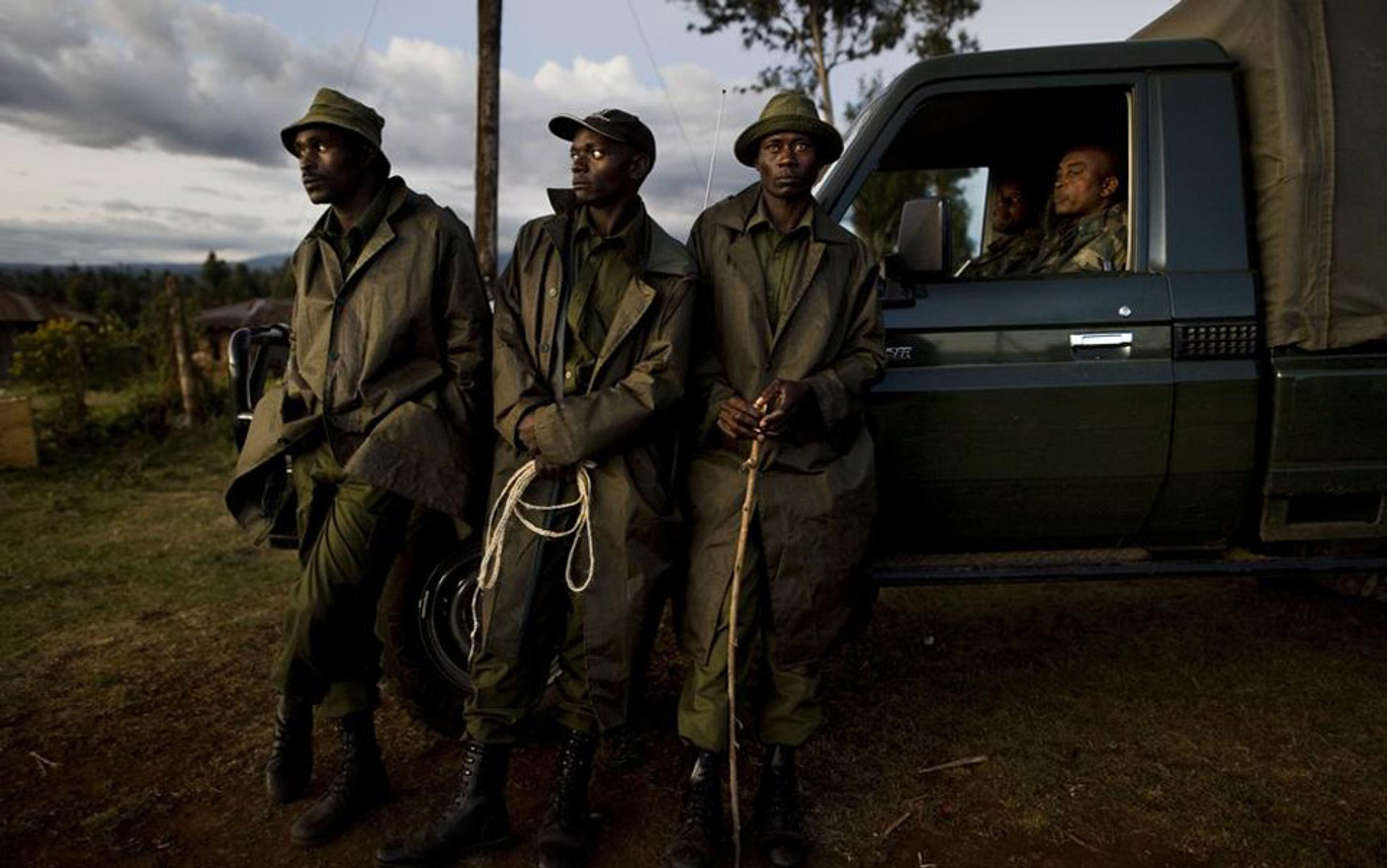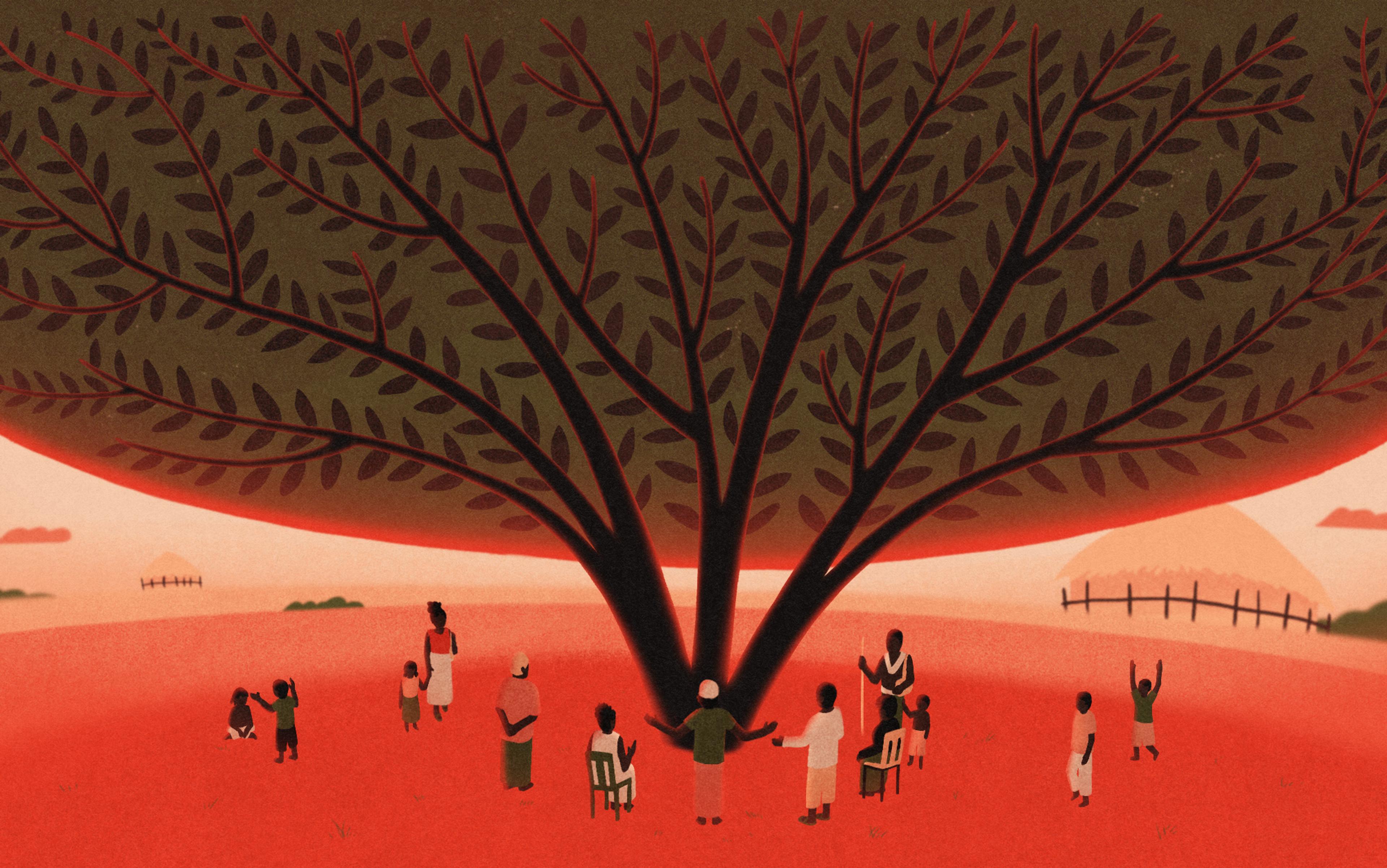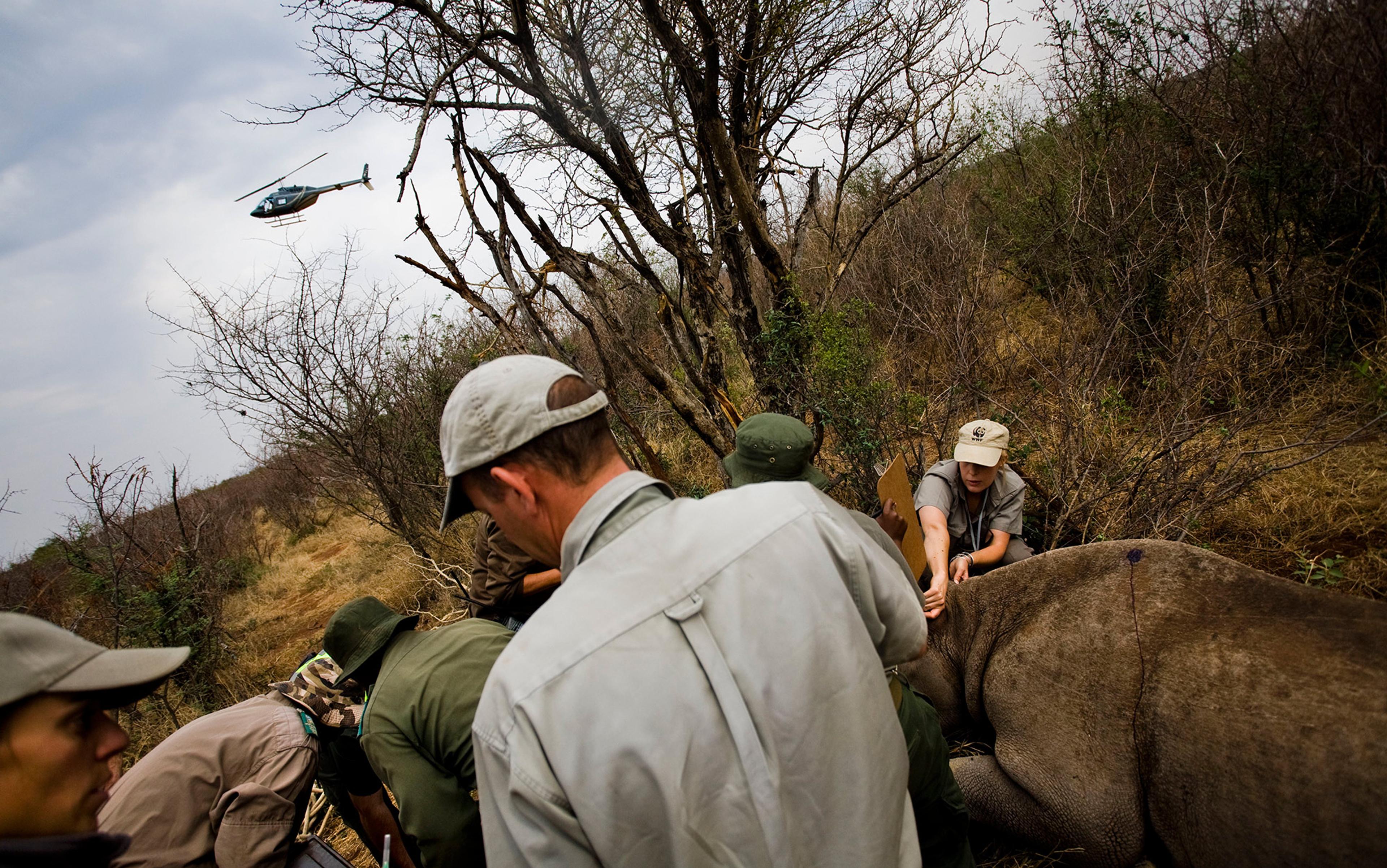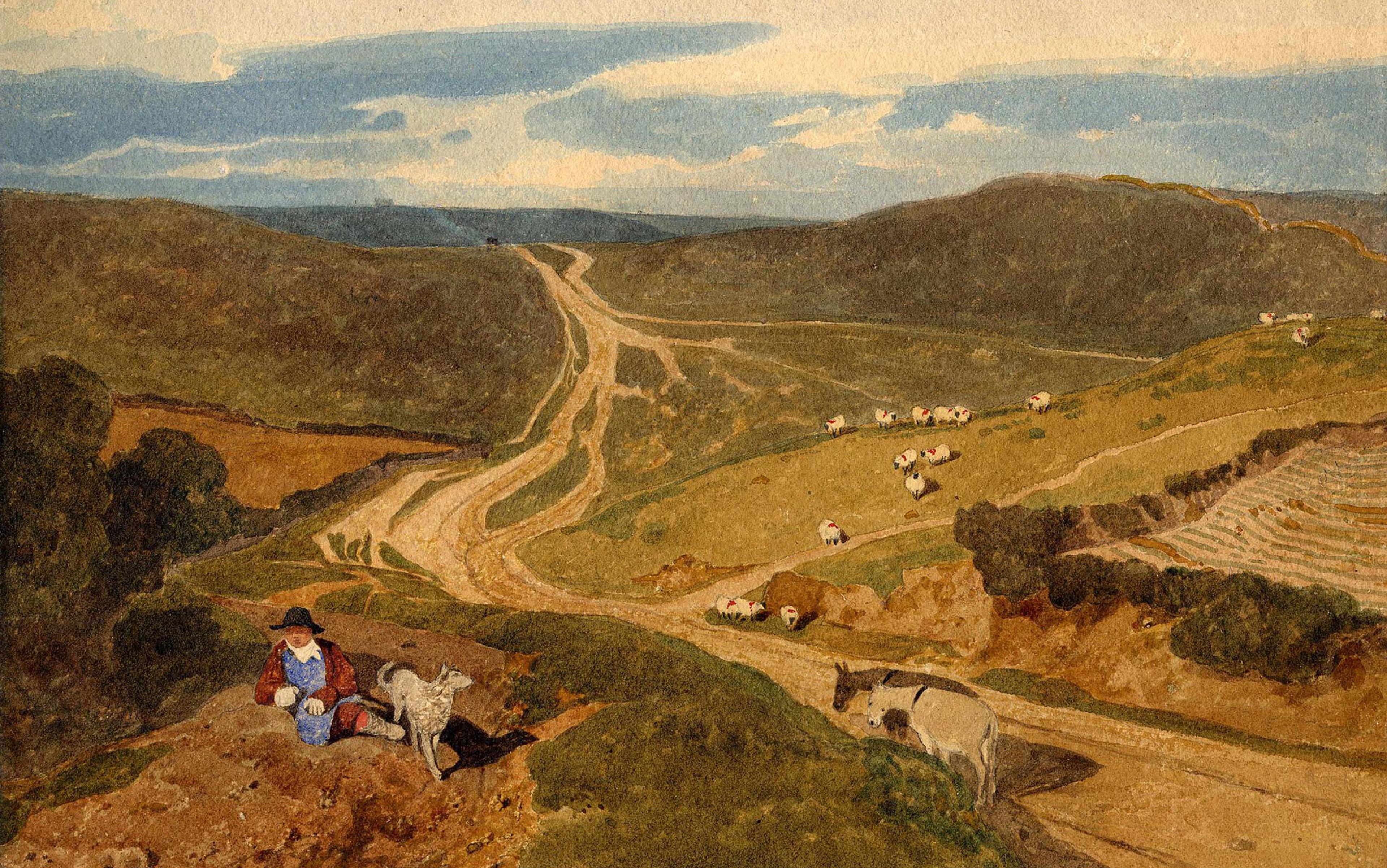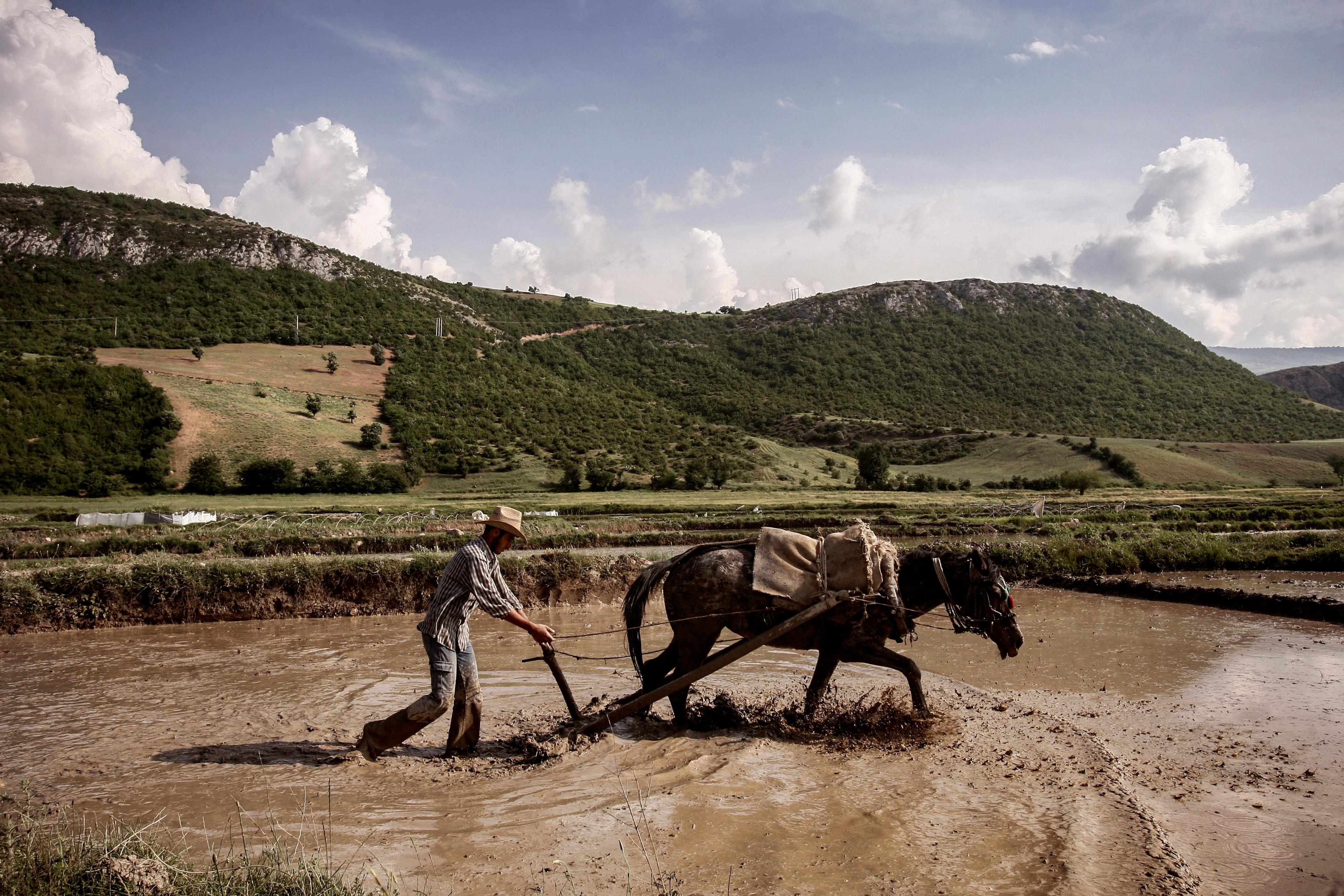Kenya’s arid north has always stirred the imaginations of those who visit. Its open, scorched bushland distributed over exposed geological formations and crosscut by riverine tentacles never fails to elicit impressions of emptiness and remoteness. To most outsiders, this is a timeless land. It is beautiful but unproductive, so the imaginary goes. It is backward. Its vulnerabilities – drought, famine, conflict, poverty – are inherent. Radical change is needed: a new way of doing things to unlock vast untapped potential and bring prosperity.
This is not a new idea. In Kenya’s north, the idea has been shaped by generations of development workers and policymakers. Its legacy today is diverse, surfacing through transformative large-scale investments and interventions across the private and public sectors. But this vision of prosperity also surfaces in the very earth itself, in the form of an invasive shrub, Prosopis juliflora (recently renamed Neltuma juliflora) or etirae in the local Turkana language.
A kind of mesquite native to South America, Prosopis was first introduced in this part of Kenya in the early 1980s at the height of a catastrophic famine caused by drought. The reason for its introduction, as cited by the NGOs spearheading the planting programmes, was to address a suite of pressing concerns made even more urgent by the protracted drought: fuelwood shortages, soil erosion and a lack of fodder for the livestock of local pastoralists.
These were real problems. But to the organisations who intervened, the issues seemed to suggest that the crisis was not really a product of chaotic environmental shifts or longstanding marginalisation. Instead, catastrophic famine served as evidence of pastoralism’s inherent vulnerability. Confirmation, that is, of a kind of fragility that lay at the heart of local people’s livelihoods and was inconducive to true prosperity. The obligation to respond to immediate hunger – to help – quickly became a desire to change, to improve, to make what was there more ‘sustainable’ or, in the more recent language of development agencies, ‘resilient’. The introduction of Prosopis, then, was part of a wave of interventions that sought to transform pastoralism, setting it on a new path towards a prosperity that is fixed, predictable and under control.
But in the decades since, the shrub has become one of Africa’s worst invasives, strangling rural livelihoods across the continent. Encroaching on farmland, forest and range, it has brought ill-health both to people and their livestock, outcompeting local flora and disrupting longstanding ways of life.
You might think the ideas that led to such a catastrophe would wither with time, but the opposite is true. Like the shrub itself, they’ve grown ever more tenacious, tangling together dissonant things in stubborn sprawling shoots that refuse to offer any resolution. This is a story about the thicket that is left behind, and what it conceals.

The banks of the Kerio river in southern Turkana County, Kenya, covered in dense Prosopis. Photo supplied by the author
For the past 12 years, my research has explored the history of development projects in Kenya’s northwest and the changing course of mobile pastoralism. I’ve interviewed hundreds, perhaps thousands of people, seeking to understand what binds together diverse mobile economies.
When I first began this anthropological work, it was in a thicket of Prosopis on the bank of the Kerio river, which arcs through the plains of Turkana County before draining into Lake Turkana. This is an area, I came to learn, that was once covered in spacious gallery forest, where regular floodwaters washed across cultivation plots laid out on meander scars, depositing in their wake rich alluvial silts. Sorghum, a common grain crop in Turkana, grew here in tall stems and flowed outward from the riverside, carried across plains, hills and scrubland by herders who loaded it into goatskin bags attached to their donkeys. Only in the harshest, cruellest of dry seasons did this resource fail the people of Turkana.
Since the 1980s, the world in which sorghum thrived has mostly been crowded out. The process began when government agencies, supported by NGOs and international donors, first introduced Prosopis to combat desertification. Projects supported by the Kenyan Forestry Department and the UN Food and Agriculture Organisation planted the shrub across riverine areas and rangelands, promoting it as a natural solution to ecological and economic challenges. Before long, Prosopis had invaded native forests and areas cleared for cultivation. Then reports began to emerge of serious gastrointestinal problems and tooth decay in the livestock who ate it. By the early 2000s, farmers and herders across northern Kenya were voicing concern, but it was not until 2008 that the Kenyan government classified the plant as an invasive species.
‘Porridge. People were fat from eating it. I can’t remember the last time we had it here’
When I arrived in Turkana in 2012, the Kerio river was strangled in relentless green. So were the old cultivation plots, which now lay fallow – it had been impossible, for many, to clear them in time for planting. Thick green walls towered over the ghosts of past rhythms and relationships.
Emeri Lowasa, whom I have interviewed on innumerable occasions, and whose family I’ve lived and worked with for many years, began cultivating this land in the 1960s when she was a young woman newly married. Now her home stands like a rocky bluff in a rising tide.
When I interview her about her family’s sorghum farm, she sits delicately in front of it, serene amid a frenetic sea of leaves and thorns. Her grandchildren cut in and out of pathways that disappear down to a river she can no longer see. ‘Porridge,’ she says, waving her hand as though in disbelief, ‘sorghum from the farm mixed with milk poured out from gourds. People were fat from eating it. I can’t remember the last time we had it here.’
It is not porridge that nourishes those settled along the Kerio now, but often a kind of paste called Plumpy’Nut, a peanut-based emergency food made by a French company and distributed sporadically by aid agencies such as UNICEF to treat malnutrition. The world in which packets of Plumpy’Nut circulate – the settlements dotted along the banks of the Kerio in Turkana – is one radically transformed by a host of other interventions, too, all of which have come to be tangled up in the steady invasion of Prosopis.
These settlements now abound with churches, schools, bars and shops. Money flows from folds in robes to cashboxes. Motorbikes chunter day and night. And by the roadside, sun-bleached signs proclaim proud support of generously funded interventions. This new world is relentless, crafted by local aspiration and ambition as much as it is by outside interventions. Nevertheless, it is not universally venerated. There are hopes and desires to which it does not cater.

Land once farmed, now abandoned to spreading thicket. Photo supplied by the author
Emeri takes a stoic view. It pleases her, she says, to see young people pursue meaning in these new horizons. But her daughter, Aemun, who married into a nomadic family and continues to subsist on livestock, sees things differently. To her, the social and economic changes that have percolated through the steady advancement of Prosopis are neither pleasing nor seductive.
‘In the past,’ Aemun says, ‘people believed in God and livestock. Then people came with this noise, with Christianity, with the banging of drums, and God went far away. Before, he was close, you could have better access, but since these recent changes he has been chased far away.’
In pastoralist areas across Africa, the virtue of intervention is not often interrogated by outsiders
Her words are weighted with a sense of unease. Does ‘development’, here, lead only in a single direction? And what, precisely, is the prosperity it seeks to bring about? How is it measured and assessed against local values?
Whatever the answers to these questions, in pastoralist areas across Africa’s arid and semi-arid lands (or ASALs, as they are termed in the acronymised world of development) the virtue of intervention is not something that is often interrogated by outsiders.
In 1977, shortly before widespread planting of Prosopis, the UN convened a conference on desertification in Nairobi. As part of the event, Kenya produced a research paper that clarified what local experts envisaged as the underlying cause of environmental degradation: ‘improper livestock and range management’ – pastoralism itself. In other reports, workshops and summits, pastoralism was envisaged as an implicitly backward lifestyle, both vulnerable and destructive.
Over the ensuing years, as the roots of Prosopis grasped deeper into the soil and its branches have thickened, global understandings of nomadic life in Africa’s drylands have also matured. Desertification is now understood to be a far less straightforward phenomenon, and pastoralism has come to be known as a highly dynamic livelihood, built on shifting social and economic relationships, which allows communities to make the most of uncertain conditions rather than buttressing against them.
And yet, like Prosopis, the ideas that shape development hold fast in the substructure, outcompeting anything less dogged. Prosperity, to those intervening, means stability, predictability and control. Instead of pastoralism, they say, support ‘livelihood diversification’. Rather than flexibility in diet and lifestyle, pursue ‘food security’.
In the midst of new calamities, these old narratives are resurfacing and beginning to germinate in the dust and sand. ‘Climate change,’ writes the lawyer and policy expert Michael Ochieng Odhiambo, ‘feeds an age-old narrative about the ASALs – that which views [them] as degraded and blames pastoral land use for the degradation.’

Market day in Nakurio on the banks of the Kerio. Photo supplied by the author
Follow the Kerio upstream for 130 miles and a great valley emerges from the scrub. Steep escarpments rise into forests and colder climes. Sloping bluffs throw bee-eaters and hornbills out into sharply forested gorges, and over quartz exfoliating in channels. Here, the river permanently flows with clear water. It is abutted on one side by sprawling plains and livestock. On the other side, farms are fed by water furrows that have been carefully managed by local communities for generations – a living system, the lifeblood of Marakwet society, reaching back hundreds of years.
I first came here in 2012, when I was an attaché at the British Institute in Eastern Africa. A long journey by bus on rough roads delivered me into the hospitality of a community grappling with a complex entanglement of social, economic and political changes. My task was to collaborate with a team of local researchers working to document this transformation; to understand its course and what drives it.
Today, Prosopis can be found here, too, though not in such dense formations as in Turkana. Far more proximate and yet no less freighted with questions is a vast irrigation scheme, abandoned at the river’s edge. Fields cleared of local trees now stand riddled with steel and plastic. Broken pipes cross-cut the dry earth.
Fixations with agricultural productivity have become tangled up with notions of progress and modernity
This scheme bears little resemblance to the system long managed by Marakwet communities. Not because the more recent project is, or at least once aspired to be, new and innovative, but because it is the opposite. It is cumbersome, uncareful, ill-conceived.
The scheme was first established in 2014 by a humanitarian agency seeking to improve food security and build peace. It collapsed within two years. Why? Like the Prosopis planting programmes in Turkana, it harboured a fundamental premise that prosperity might be achieved with easy, technical fixes.
Where Turkana pastoralism was deemed fragile and destructive, Marakwet farming was pictured as fundamentally unproductive – anathema to a version of prosperity measured primarily in terms of yields, income and GDP. This version, as pointed out by the anthropologist Henrietta Moore, has shaped development in rural Africa for more than a century as fixations with agricultural productivity have become tangled up with notions of progress and modernity. This view renders development unilinear and the past it replaces as passive and primordial. It has also contributed to, Moore writes, ‘a failure to envisage what prosperity might mean and entail for Africa on its own terms and through the visions of its citizens.’
In Marakwet, this failure can be seen in the new irrigation scheme’s total circumvention of more than two centuries of local growth and innovation. This Marakwet version of prosperity includes 200 miles of irrigation channels, as well as shifting patterns of soil maintenance, tenure, crop diversity, labour allocation and fallowing, all of which respond dynamically to a changing horizon of constraints and possibilities. Channels that were once made only of wood have been remade by local farmers as new materials like plastic and concrete have become available. New seed varieties have been adopted, new technologies harnessed, and new market opportunities exploited. There is nothing passive about Marakwet farming. In short, this is a world perpetually under construction, moulded through continually transforming practices.

An irrigation furrow, managed for generations and part of a complex network of many others, Marakwet. Photo courtesy of Matthew Davies
The team from the Marakwet community I met in 2012 has developed a close collaborative relationship with social scientists at University College London. Together, they have studied this world in all its complexity for almost 15 years, carefully mapping the movements of irrigation channels and changes in agricultural practices and land use. Their work has underlined how Marakwet farmers have always been proactive about embracing novelty and making it work on their own terms. The irrigation scheme was no exception. Local participants welcomed it enthusiastically when it was first constructed in 2014.
Timothy Kipkeu Kipruto, director of the Marakwet Research Station, points out that local participants never saw involvement in the scheme as a particularly radical departure from what they had always done. ‘It is not usual here to reject something just because it is different,’ he says. ‘Even if you try something and it fails, no one will see it as a shame, they’ll say, I’ve tried, I’ve learned. That’s how people saw this project, another opportunity to be incorporated into community life.’ Its failure, in this sense, cannot be explained away as a lack of ‘local buy in’ or an unfortunate shift in circumstances or funding.
The land hangs open. The earth is steeped in confusion, discomfort
The initiative failed precisely because it never understood how it might become a part of this life. The local context – patterns of learning and living – was not imagined as a source of distinct ideas, hopes and ambitions to be apprehended. It was seen merely as a blank and apathetic canvas. And so, the project stumbled clumsily into a series of complex inter-ethnic and inter-clan relationships shaping land tenure and resource management. Its simple, technology-oriented unifying plan fragmented into a mosaic of problems.

Pipes put in place in 2014 for the new irrigation scheme, crumbling now due to inaction. Photo courtesy of Sam Lunn-Rockcliffe
Today, tree-stripped bushy clearings stretch along the river. Soil once permeated with the old roots of acacias now abounds only in dry pipes and thicket. The land hangs open. The earth is steeped in confusion, discomfort.
Is the world of development moving on from mistakes like this? Perhaps on paper. References are now often made to ‘Indigenous knowledge’ and ‘community-based adaptation’. Yet, in much of the discourse, such knowledge remains deeply misunderstood. It comes across as passive and fixed to a kind of primordial version of society. When new technologies or methods are introduced, this is viewed as ‘hybridity’: an ageless past finding purchase in modernity.
Such visions of rural life, indeed of history, in sub-Saharan Africa are not only features of NGO development projects. As we enter a new turbulent era marked by radically constricted aid budgets and a global contraction in development funding, the danger is transposed. The kinds of investment and growth that now stand to take over the reins are state-led ‘mega-projects’ seeking to push the limits of modernisation further into the hinterlands. Since the dawn of the new millennium, the African continent has witnessed a steady proliferation of such projects. Dams, deep-water harbours, irrigation schemes, mines and roads have come surging through storied landscapes behind tractors and bulldozers. This flurry of activity is a moment the geographer Pádraig Carmody calls a ‘new scramble for Africa’.

Looking east from Tot-Sibou village, towards the abandoned irrigation scheme. Courtesy of Sam Lunn-Rockcliffe
What vision of prosperity does such massive, cleaving change harbour? Peel beneath the surface and you will find a familiar set of old ideas: rural folk are passive and outmoded. Their future must be built for them.
Sixty miles further south and the Kerio is at its source. From here, it is still more than 400 miles to the coast and the warm waters of the Indian Ocean – a journey that takes me past all kinds of livelihood and lives. City gives way to suburb, then to open grassland, then to town again. Traders call to passers-by, encircled in bands of fresh light and the winding tracks of motorbike taxis. Handcarts are heaved along pathways, laden with sacks of potatoes or plastic for recycling.
Along the way, I pass south of the Galana Kulalu Food Security Project, a leviathan lying in limbo, financed through a combination of government funding and international private investments. This ‘million acre’ irrigation project was once deemed too big to fail, but has stalled since 2019. An investment of $72 million has done little to avoid a suite of community-level complaints about exclusion from decision-making and access to land and jobs. High expectations have given way to an impenetrable fog of confusion and distrust. There is a feeling that great, upending change has come only to unsettle and disturb, not to improve. A sense that the dust, when it settles again, will fall directly onto the very social and economic problems that prefigured the intervention.
This scheme is not alone. Kenya has witnessed many such projects in recent years as part of the resurgence of a form of development thought to be confined to the past. In many cases, these projects have been justified and rationalised in relation to climate change, a calamity that demands newer, more colossal approaches to longstanding needs.
His tree nursery stands shrouded in shade net. His saplings are lined up in rows
Yet trailing behind this urgent framing, and the familiar vision it propels, is an equally familiar kind of disarray. Consider some recent cases. The Napuu II irrigation project in Turkana seems to have increased local hunger; the Tana Delta Irrigation Project on the north coast collapsed despite a further investment of $700,000; and the Perkerra irrigation scheme in Baringo faces impending failure due to a volatile and unreliable water supply. All are manifestations of a single idea: massive agricultural investments to the tune of millions of US dollars should come hand in hand with centralised management and new forms of stabilising control. The prosperity they presage is not tangible, but looming, ambiguous and expressed, always, in relation to GDP.
Before the ocean lies Mombasa, one of Africa’s oldest cities. From here, the road winds southward to the Shimba Hills, where the same vision finds perhaps its fullest expression. This is a land sleeping in deep green and shadow, with a national rainforest and woodland reserve at its heart. Daniel Ndegwa is in his 30s and has lived here his whole life.
We first met when we were both 18. Back then, I was living in a neighbouring village with a friend of my family’s. Over the years, we’ve stayed in touch, become good friends, even worked together on a research project exploring the history of Kenya’s coast. When I find him to talk about the changes shaping this region, he takes me to his latest project.
He slips though branches, the slope narrowing to a clearing where his tree nursery stands shrouded in shade net. His saplings are lined up in rows. They shoot out from soil encased in plastic. All around are loftier, older trees that have stood for generations, the life of humans unfolding at breakneck pace beneath their branches. Enormous, silver barked mvumo palms tower above clusters of African teak, the ones his father calls mvule. The glossy grey of mbambakofi, or pod mahogany, shimmers in the shadow, its giant canopy reaching over to the other side of the dirt path. Elsewhere on this coast are trees called mkelekele and mkilifi, so emblematic that their names have been given to local settlements. Trees like these once covered the Shimba Hills. Daniel, like many others from this coastal region, is anticipating a need for regrowth. His nursery is no hobby, it is a business.

Daniel Ndegwa tending to his tree nursery. Photo supplied by the author
A stone’s throw away from Daniel’s nursery, the green gives way to barren red earth and dust. No more are the quiet contours of trunk and leaf. The trees have been decimated. The horizon is dotted with heavy machinery, tearing through land that once thronged with birds, monkeys, sometimes buffalo. ‘The trees could not have known,’ his father back home says, ‘that they were growing in soil full of minerals.’ Then he slaps his palms together over the brooms he’s been making in the shade of a mwarubaini tree. ‘Titanium!’
After years of intensive discussion, and opposition from many community leaders, the mining finally began in 2008. Since then, entire communities have been relocated. A land once full of human rhythm has fallen eerily still. ‘The people were paid per acre,’ Daniel says, ‘and some according to the kinds of trees they had on their land, what their value was in terms of fruit.’ The money they were given was substantial compensation, but for many it is now as much a memory as their old home. Daniel lifts his chin to the open space: ‘Even those who received the most, many of them spent it all within a year. Now they’re poor again.’ Prosperity, here, was abridged. It was imagined solely as more money. And in this abridgement, advantageous though it may have been to those who stood to gain the most, certain considerations were crowded out: history, community, fulfilment, belonging.

The mineral mining site in Kwale. Photo supplied by the author
Now the topsoil has been sifted of its minerals, the replanting programmes will begin. Perhaps, in 100 years, something of what was here will return. In the meantime, Daniel busies himself, his work advancing in shadow. His efforts are like those of other Kenyans: Marakwet farmers who tried their best to capitalise on new irrigation investments, women who now cut and burn Prosopis in Turkana and sell it to passing lorries as charcoal, men who build houses with its timber. This is quiet work. Unnoticed, often, by outsiders.
Some of the Prosopis trees in the Americas are 1,000 years old. But, there, the species has long been entangled with a different picture of prosperity. It has been honoured by its human neighbours, its fibre, thorns and sap making many objects essential to a good life. It has mended pottery, made flour and beer. Perhaps then, even here in Kenya, there is some universal good that might one day be unlocked from this strange species. But, looking back, history suggests otherwise.
If Kenya’s long entanglement with international development teaches us anything, it is that prosperity swells from the ground up. It must be nurtured, not imposed.
Why is a sentiment so obvious and intuitive crowded out from the contexts where it matters most? You won’t find it in the rooms in which decisions and deals are made, or the meetings that take place between governments and investors. Perhaps such a question is too naive, akin to asking why it is so difficult to reach a global consensus on co-ordinated efforts to tackle climate change. Perhaps the answer is obvious: what begins as a mobilising imperative – urgent, moral, widely shared – soon becomes a battleground. This is not a place for listening and learning, but for competing interests and combative negotiations of new dangers and opportunities. Here, in this listing battleground, there is no time to take stock of the everyday things that give human lives meaning. There is no time to recognise the ideologies silently at work, until they are undeniable.

A mkelekele tree. Photo supplied by the author

